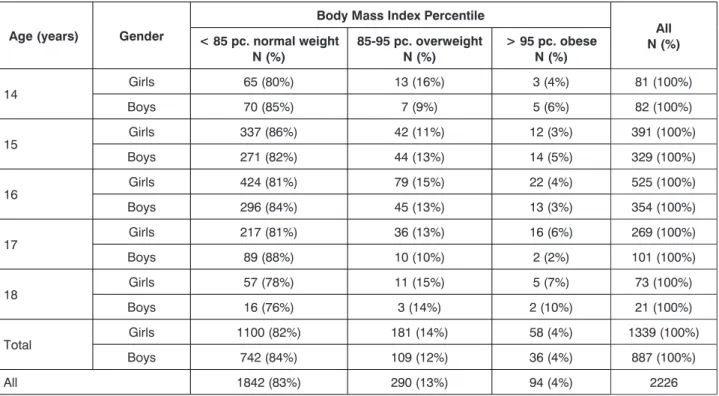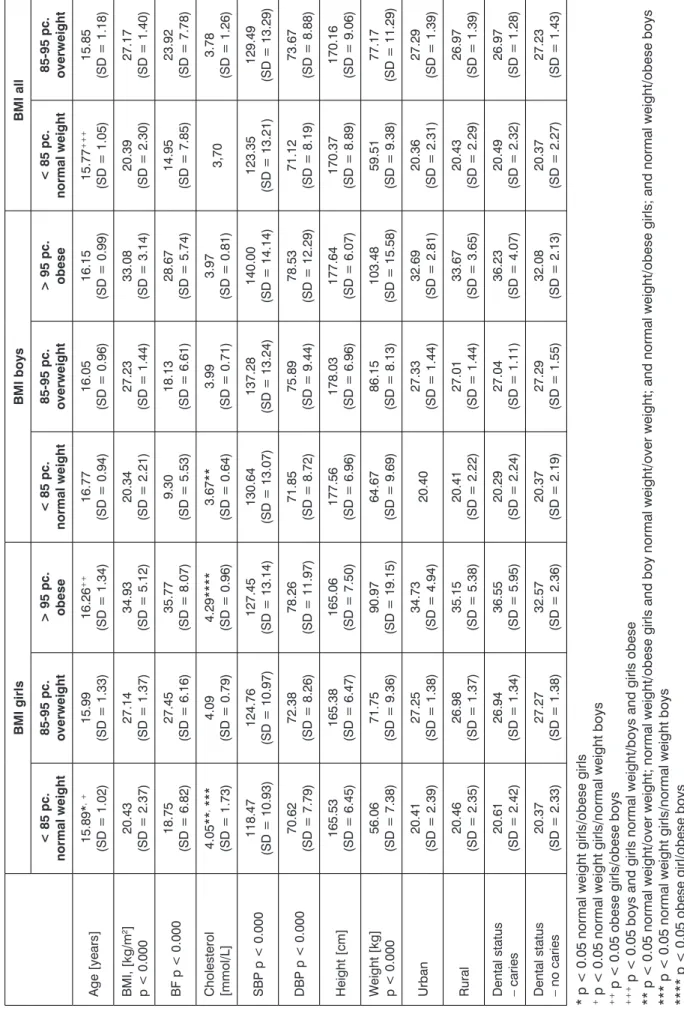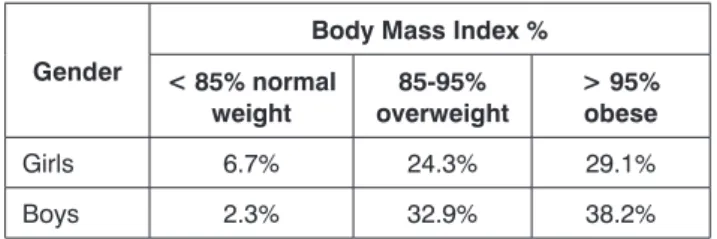New Medicine 137
4/2016
© Borgis
IntroductIon
obesity and hypertension are two most important risk factors for cardiovascular diseases (1, 2).
obesity is one of the most common health problems of the developed countries. the prevalence is increasing among adults and children alike. In Hungary, the preva- lence in children is 9-10%. In 1998, WHo (World Health organization) classified obesity as a disease. obesity, and other metabolic, endocrine and musculoskeletal diseases that are caused by obesity are seen as one of the biggest public health-related problem nowadays.
obesity increases the morbidity and mortality in all the populations.
AIm
the aim of this screening was to investigate the fre- quency of obesity and its association with hypertension in a sample of children and adolescents in Budapest.
the results of the study will help to design programmes for the prevention and controll of the disease in child-
hood, which could decrease the potential of chronic dis- ease in adulthood.
mAterIAl And metHods
A screening program was conducted between April 2010 and may 2011 in Budapest. the screening pro- gram was conducted by the city council and with medi- cal supervision of the professionals from the “Heim Pál”
children Hospital in Budapest.
the screening program was financed by the city council of Budapest. the screening consisted of mea- suring blood pressure, heart rate, cholesterol, blood glucose, weight, height, calculating BmI, and determi- nation of body composition.
A sample of 2467 healthy children and adoles- cents (958 boys and 1509 girls) from the selected schools participated in the study. there were no special inclusion criteria. the participation in the screening program was voluntary and informed consent from the parents, as well as from the adolescents, was obtained in all cases. the
CardiovasCular sCreening program in Children in Budapest
*Judit Kormos-Tasi
1, Erika Gácsi
1, Fanni Tóth
2, Antal Czinner
1, 2, László Szabó
1, 21department of Family care methodology Faculty of Health sciences, semmelweis university, Budapest, Hungary
Head of Faculty: Professor Zoltán Zsolt nagy, Phd
2Heim Pál children Hospital, Budapest, Hungary Head of Hospital: Anikó nagy, md
summary
Introduction. obesity is one of the most common health problems of the developed countries. the prevalence is increasing among adults and children alike. in hungary, the prevalence in children is 9-10%. in 1998, Who (World health organization) classified obesity as a disease. obesity, and other metabolic, endocrine and musculoskeletal diseases that are caused by obesity are seen as one of the biggest public health-related problem nowadays. obesity increases the morbidity and mortality in all the populations.
Aim. the aim of our screening program was to investigate the prevalence of obesity and its association with hypertension in children.
Material and methods. a screening program was conducted between april 2010 and may 2011. the screening consisted of measuring blood pressure, heart rate, cholesterol, blood glucose, weight, height, calculating Bmi, and determination of body composition.
Results. 2226 children aged 14-18 fullfilling the inclusion criteria participated in the program. 13% of the participants were overweight (i.e. their Bmi was in between the 85th and 95th percentile of the Bmi for their age) and 4% of them were obese (i.e. their Bmi was above the 95th percentile for their age). high body fat content was detected in 12.98% of girls and 5.9% of boys that participated in the study. 66% of girls and 81% of boys with elevated Bmi had high body fat content.
mean cholesterol level was significantly higher in the group of overweight and obese participants than in the group of par- ticipants with normal Bmi. mean systolic and diastolic blood pressure differed significantly between groups with different Bmi for both girls and boys, with overweight participants most likely to have pathologically high blood pressure.
Conclusions. there was a significant increase in both systolic and diastolic blood pressure with an increase in Bmi. the results of our study may help design preventive programmes for obesity and hypertension in children.
Keywords: children obesity, hypertension, screening
© Borgis new med 2016; 20(4): 137-140 doI: 10.5604/14270994.1228165
138 New Medicine
4/2016
Judit Kormos-Tasi et al.
weight, height, BmI, and blood pressure, mean and range were calculated. categorical variables were sum- marized by count and percentage. the data was ana- lysed using the sPss statistica 20.0 software. level of statistical significance alpha was defined as p < 0.05.
results
the distribution of BmI, age and gender of the study participants is shown in table 1. mean age was 15 year (sd
= 1.18). 13% of children were overweight and 4% were obese. detailed characteristics of the population by BmI are shown in table 2. the mean body fat percentage (BF) was pathologicaly high in 12.98% of all girls and 5.9% of all boys, and in the groups with elevated BmI the frequen- cy of high BF was 66% in girls and 81% in boys. the mean cholesterol was significantly higher in the overweight and obese groups (tab. 3). the mean systolic and diastolic blood pressure was significantly different (p < 0.05) be- tween BmI groups and between sexes. High blood pres- sure was most frequently found in the group of overweight boys and girls (tab. 4). After comparing BmI between chil- dren from urban and rural stations, no statistically signifi- cant difference was found. caries was found to be signifi- cantly more common in obese children.
In our study, 20% of children had an initially elevated BP at the first measurement.
dIscussIon
obesity of children and adolescents has become a global health problem (1, 2). In our study, 13% of the participants were overweight and 4% of them were obese.
study was approved by the Institutional research ethical committee of Heim Pál children Hospital, Budapest.
our screening program was a local program conduct- ed in Budapest, in which we examined different areas:
full orthopedic screening, eyesight screening, hearing screening, dentistry screening, internal medicine screen- ing, celiac screening, cardiovascular screening and men- tal hygiene test as described previously in ”new medi- cine” in 2014 (3). the included students took part in all types of examinations, but in this study, we only analyze the results of the cardiovascular program. obesity was defined as having BmI value greater than 95th percentile for participant’s age and sex, and overweight was defined as having BmI value between the 85 and 95th percentile.
the body composition was measured through multi- frequency bioelectric impedance analysis (Inbody 3.0 Biospace device). We considered the body fat (BF) to be abnormally high when it was greater than 25% for boys and 30% for girls (4). the serum cholesterol level greater than 5.0 mmol/l and fasting blood glucose greater than 5.5 mmol/l was considered abnormal.
Blood pressure was measured using a standardized automatic blood pressure meter. to diagnose hyper- tension in pediatric population, systolic and/or diastolic pressure value greater than 95th percentile for age, sex and height is required (5). If a student had mean blood pressure greater than the 95th percentile for age and height, their blood pressure was remeasured at Heim Pál children Hospital due to safety considerations.
microsoft office excel was used to process the col- lected data. For continuous variables, including age,
tab. 1. number (percentile) of screened population by BmI, age and gender Age (years) Gender
Body Mass Index Percentile
All N (%)
< 85 pc. normal weight
N (%) 85-95 pc. overweight
N (%) > 95 pc. obese N (%)
14 Girls 65 (80%) 13 (16%) 3 (4%) 81 (100%)
Boys 70 (85%) 7 (9%) 5 (6%) 82 (100%)
15 Girls 337 (86%) 42 (11%) 12 (3%) 391 (100%)
Boys 271 (82%) 44 (13%) 14 (5%) 329 (100%)
16 Girls 424 (81%) 79 (15%) 22 (4%) 525 (100%)
Boys 296 (84%) 45 (13%) 13 (3%) 354 (100%)
17 Girls 217 (81%) 36 (13%) 16 (6%) 269 (100%)
Boys 89 (88%) 10 (10%) 2 (2%) 101 (100%)
18 Girls 57 (78%) 11 (15%) 5 (7%) 73 (100%)
Boys 16 (76%) 3 (14%) 2 (10%) 21 (100%)
total Girls 1100 (82%) 181 (14%) 58 (4%) 1339 (100%)
Boys 742 (84%) 109 (12%) 36 (4%) 887 (100%)
All 1842 (83%) 290 (13%) 94 (4%) 2226
New Medicine 139
4/2016
Cardiovascular screening program in children in Budapest
tab. 2. detailed characteristics of the population by BmI BMI girlsBMI boysBMI all < 85 pc. normal weight85-95 pc. overweight> 95 pc. obese< 85 pc. normal weight85-95 pc. overweight> 95 pc. obese< 85 pc. normal weight85-95 pc. overweight Age [years] 15.89*,+ (sd = 1.02)15.99 (sd = 1.33)16.26++ (sd = 1.34)16.77 (sd = 0.94)16.05 (sd = 0.96)16.15 (sd = 0.99)15.77+++ (sd = 1.05)15.85 (sd = 1.18) BmI, [kg/m2] p < 0.000 20.43 (sd = 2.37)27.14 (sd = 1.37)34.93 (sd = 5.12)20.34 (sd = 2.21)27.23 (sd = 1.44)33.08 (sd = 3.14)20.39 (sd = 2.30)27.17 (sd = 1.40) BF p < 0.000 18.75 (sd = 6.82)27.45 (sd = 6.16)35.77 (sd = 8.07)9.30 (sd = 5.53)18.13 (sd = 6.61)28.67 (sd = 5.74)14.95 (sd = 7.85)23.92 (sd = 7.78) cholesterol [mmol/l]4.05**, *** (sd = 1.73)4.09 (sd = 0.79)4.29**** (sd = 0.96)3.67** (sd = 0.64)3.99 (sd = 0.71)3.97 (sd = 0.81)3,703.78 (sd = 1.26) sBP p < 0.000 118.47 (sd = 10.93)124.76 (sd = 10.97)127.45 (sd = 13.14)130.64 (sd = 13.07)137.28 (sd = 13.24)140.00 (sd = 14.14)123.35 (sd = 13.21)129.49 (sd = 13.29) dBP p < 0.000 70.62 (sd = 7.79)72.38 (sd = 8.26)78.26 (sd = 11.97)71.85 (sd = 8.72)75.89 (sd = 9.44)78.53 (sd = 12.29)71.12 (sd = 8.19)73.67 (sd = 8.88) Height [cm]165.53 (sd = 6.45)165.38 (sd = 6.47)165.06 (sd = 7.50)177.56 (sd = 6.96)178.03 (sd = 6.96)177.64 (sd = 6.07)170.37 (sd = 8.89)170.16 (sd = 9.06) Weight [kg] p < 0.000 56.06 (sd = 7.38)71.75 (sd = 9.36)90.97 (sd = 19.15)64.67 (sd = 9.69)86.15 (sd = 8.13)103.48 (sd = 15.58)59.51 (sd = 9.38)77.17 (sd = 11.29) urban20.41 (sd = 2.39)27.25 (sd = 1.38)34.73 (sd = 4.94)20.4027.33 (sd = 1.44)32.69 (sd = 2.81)20.36 (sd = 2.31)27.29 (sd = 1.39) rural20.46 (sd = 2.35)26.98 (sd = 1.37)35.15 (sd = 5.38)20.41 (sd = 2.22)27.01 (sd = 1.44)33.67 (sd = 3.65)20.43 (sd = 2.29)26.97 (sd = 1.39) dental status – caries20.61 (sd = 2.42)26.94 (sd = 1.34)36.55 (sd = 5.95)20.29 (sd = 2.24)27.04 (sd = 1.11)36.23 (sd = 4.07)20.49 (sd = 2.32)26.97 (sd = 1.28) dental status – no caries20.37 (sd = 2.33)27.27 (sd = 1.38)32.57 (sd = 2.36)20.37 (sd = 2.19)27.29 (sd = 1.55)32.08 (sd = 2.13)20.37 (sd = 2.27)27.23 (sd = 1.43) * p < 0.05 normal weight girls/obese girls + p < 0.05 normal weight girls/normal weight boys ++ p < 0.05 obese girls/obese boys +++ p < 0.05 boys and girls normal weight/boys and girls obese ** p < 0.05 normal weight/over weight; normal weight/obese girls and boy normal weight/over weight; and normal weight/obese girls; and normal weight/obese boys *** p < 0.05 normal weight girls/normal weight boys **** p < 0.05 obese girl/obese boys there was no statistically significant difference between the children who lived in rural and urban area.
140 New Medicine
4/2016
Judit Kormos-Tasi et al.
measurement only, 68% of boys and 43% of girls de- veloped prehypertension or hypertension within the next two years (5). Hypertension is reported to be more prevalent in urban regions than in rural areas (15). In our study, we did not observe such a relationship.
conclusIons
there was a significant increase in both systolic and diastolic blood pressure with an increase in BmI.
the high prevalence of hypertension in overweight and obese children implies that there is need for more ef- ficient prevention in health basic service.
AcknoWledGements
the authors would like to thank Professor Antal czin- ner, who initialised the study and unfortunately departed before the end of the project.
References
1. Landsberg L, Aronne LJ, Beilin LJ et al.: Obesity-related hyperten- sion: pathogenesis, cardiovascular risk, and treatment: a position paper of The Obesity Society and the American Society of Hypertension. Obesity 2013; 21: 8-24. DOI: 10.1002/oby.20181. 2. Ogden CL, Carroll MD, Kit BK, Flegal KM: Prevalence of obesity and trends in body mass index among US children and adolescents, 1999-2010. JAMA 2012; 307: 483-490.
3. Kormos-Tasi J, Szabó L, Bossányi É et al.: Results of the child obesity – “Tabula rasa” screening program. New Med 2014; 2: 72-74. 4. Czinner A:
A szív-ésérrendszeri megbetegedések gyermekkori prevenciója. Medicina Könyvkiadó Rt. Budapest 2003: 27. 5. Falkner B, Daniels SR: Summary of the fourth report on the diagnosis, evaluation, and treatment of high blood pressure in children and adolescents. Hypertension 2004; 44: 387-388.
6. Basiratnia M, Derakhshan D, Ajdari S, Saki F: Prevalence of childhood obesity and hypertension in south of Iran. Iran J Kidney Dis 2013; 7: 282- 289. 7. Valdés Pizarro J, Royo-Bordonada MA: Prevalence of childhood obesity in Spain: National Health Survey 2006-2007. Nutr Hosp 2012; 27:
154-160. 8. Kollias A, Skliros E, Stergiou GS et al.: Obesity and associated cardiovascular risk factors among schoolchildren in Greece: a cross- sectional study and review of the literature. J Pediatr Endocrinol Metab 2011; 24: 929-938. 9. Raison J, Achimastos A, Asmar R et al.: Extracellular and interstitial fluid volume in obesity with and without associated systemic hypertension. Am J Cardiol 1986; 57: 223-226. 10. Flynn JT, Falkner BE: Obesity hypertension in adolescents: epidemiology, evaluation, and management. J Clin Hypertens (Greenwich) 2011; 13: 323-331. 11. Pall D, Katona E, Fulesdi B et al.: Blood pressure distribution in a Hungarian adolescent population: comparison with normal values in the USA. J Hypertens 2003; 21: 41-47. 12. Muntner P, He J, Cutler JA et al.: Trends in blood pressure among children and adolescents. JAMA 2004; 291(17):
2107-2113. 13. Steinthorsdottir SD, Eliasdottir SB, Indridason OS et al.:
Prevalence of hypertension in 9- to 10-year-old Icelandic school children.
J Clin Hypertens (Greenwich) 2011; 13: 774-779. 14. Sharma A, Grover N, Kaushik S et al.: Prevalence of hypertension among school children in Shimla. Indian Pediatr 2010; 47: 873-876. 15. Ibrahim MM, Damasceno A:
Hypertension in developing countries. Lancet 2012; 380: 611-619.
there was no significant difference in the prevalence of obesity between boys and girls. Basiratnia et al. received similar results, but some other researchers found the per- centage of obese children to be even higher (6-8).
In our study, we diagnosed obesity in children by calculating their BmI and measuring their body fat per- centage (BF). High BF of obese subjects can contribute to the pathogenesis of their hypertension (9). the pri- mary hypertension in our subjects was rare, and was frequently secondary to kidney disease, but epidemio- logical studies showed an increase in the prevalence of primary hypertension in children and adolescents (10).
We used Hungarian guide for diagnosing hypertension in children that was published in 2010 (11). In our study, there was a significant increase in both systolic and dia- stolic blood pressure with an increase in BmI. the preva- lence of systolic hypertension was 64.5% in obese boys and 11.8% in obese girls, and 58.6% in overweight boys and 18.6% in overweight girls. Basiratnia et al. (6) re- ported lower prevalence of hypertension in children with high BmI, which complies with the results of muntner et al. (12). In our study, 20% of children had an initially elevated BP at the first measurement, proving the impor- tance of repeated measurements in diagnosing hyper- tension. other studies reported similar results (13, 14).
results of these studies have limited value, as they are based on a single BP measurement. However, among adolescents who had elevated blood pressure in single tab. 4. Percent of pathological high blood pressure, by BmI and gender
Gender Body Mass Index %
85-95% overweight > 95% obese
Girls 16.6% 11.8%
Boys 58.6% 64.5%
tab. 3. Percentage of children with cholesterol level above 5.15 umol/l, by BmI and gender
Gender
Body Mass Index %
< 85% normal weight
85-95%
overweight
> 95%
obese
Girls 6.7% 24.3% 29.1%
Boys 2.3% 32.9% 38.2%
Conflict of interest none
received: 2.09.2016 Accepted: 28.10.2016
correrspondance to:
*Judit kormos-tasi department of Family care methodology
Faculty of Health sciences semmelweis university 17 Vas str., 1088 Budapest, Hungary tel.: +36 1-486-4840, +36 2-099-42829
fax: +36 1-486-4845 e-mail: tasij@se-etk.hu


